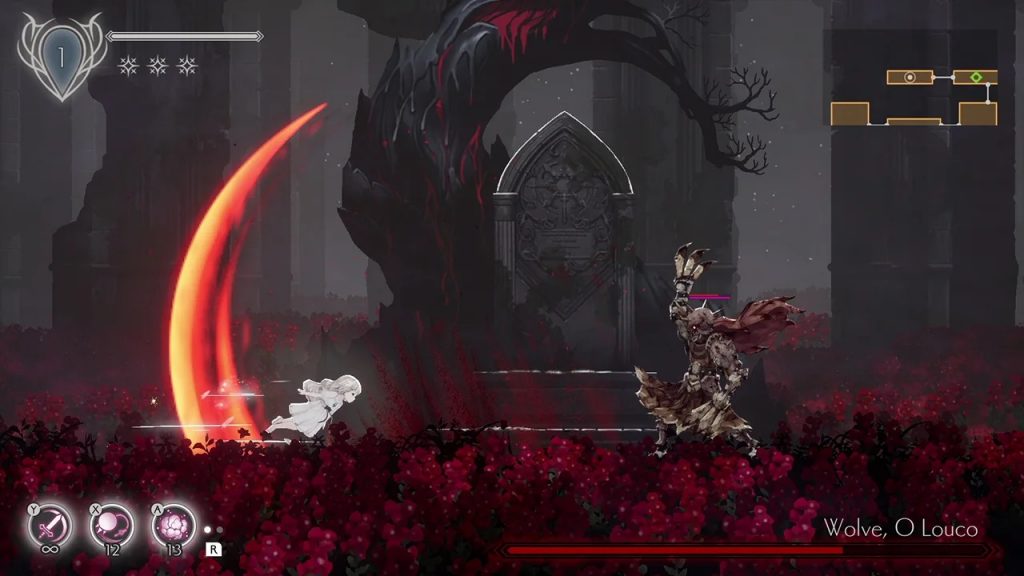Ender Lilies: Quietus of the Knights begins with the soft pitter-patter of rain and text scrawling itself along the bottom of the screen. A short exposition accompanies a beautiful illustration that showcases the player character: a young girl fast asleep with lilies in her hair and a foreboding, sinister looking brand on her forehead. She awakens alone in an unfamiliar world with the spirit of a deceased knight to guide her. This paints an evocative picture of the world of Ender Lilies and sets the tone going forward.
Most of the world is shrouded in mystery, with exposition given through memos and environmental storytelling. You begin in the bowels of a church, dilapidated and ruined. As you emerge after fighting the first boss at a weathered altar, the player begins to see the world at large. The Blight, a plague that accompanies a constant steady fall of rain, tainted the world. Only the priestess Lily can purify it. How this came to be is slowly discovered through the several different environments in Ender Lilies. While only a handful exist, the illustrations that make up the overall designs of these areas are extremely atmospheric.
There is an immense amount of detail put into the foreground and background illustrations. Softly illuminated forests and the decaying remains of a village have their own uniqueness that provide a welcome variety to the game. Especially as you backtrack through areas to obtain items you may otherwise have missed.
There are a total of three different endings the player can achieve in Ender Lilies. Taking a page from Yoko Taro games, each starts with a letter that corresponds with a unique quote. This final sentence reflects how the world is shaped by the events of the game and what will ultimately transpire based on your choice. However, Ender Lilies is ultimately a game about hope and agency–a willingness to show compassion and empathy towards those around us. It’s a beautiful story accompanied by an even more lovely score.
The gameplay for Ender Lilies changed very little from its early access stage. It still functions like a mostly competent platformer. Players can attack and dodge through enemies. There is a healing mechanic that can be used and refilled through the collection of white lily petals. But perhaps the most important mechanic is the use of summons.
Lily cannot attack on her own and must rely on the souls of the deceased to fend off those infected by The Blight. Players can equip a total of six summons at a time, which are divided into two designated sets. Some of these summons have limited skill use before you need to find a bench to rest, while others allow you to attack without abandon. That said, some summons are more useful than others. While I particularly enjoyed using a summon that took the form of a crow, it was less than useful during boss encounters.
Bosses in Ender Lilies are stock and standard, each coming with a transformation and various phases. The unique designs often designate their importance in an area, and one boss in particular can be extremely challenging. (I will not say who the boss is, due to the nature and spoilers surrounding it.) Memorizing attack patterns is key to victory, and after a couple of tries I found myself defeating them with ease. Still, brute forcing Ender Lilies is a possibility, though you can defeat each boss without taking any damage if you dedicate yourself to learning attack patterns.
Players unlock various skills through completing or exploring the various areas available in the game. This includes a handy double jump, which is required for extensive exploration and backtracking. And what Ender Lilies benefits from in this regard is a teleportation system of sorts that players unlock simply through natural progression. You don’t need to walk back to every area, but can instead teleport to any bench you have rested at. This eliminates some of the hassle and proved to be quite the time saver.
Platforming is somewhat simple, and feels heavy in comparison to other titles in the genre. Sometimes jumping can be a bit frustrating, as Lily needs to hit the edge or just below it to pull herself up. This can lead to you falling back to the bottom of stages fairly easily. But once you get the hang of it and understand where various hitboxes collide, it becomes significantly less complicated to navigate the various levels.
However, one area where Ender Lilies hasn’t improved since early access is in its user interface, and it becomes extremely glaring when playing on the Nintendo Switch. The map is relegated to the top right hand corner of your screen. You can pull up a larger version, but the mini-map is sometimes hard to read if you’re playing in handheld mode. There are also no accessibility options to make the map any larger for those with poor eyesight. Thankfully, the text is fairly large and the subtitles are easy to read. Additionally, players can remap their controls which provides some measure of accessibility on that front.
Ender Lilies proves to be a somber experience, providing a melancholy but hopeful story that utilizes environmental storytelling to its fullest. As a platformer it functions well and has its own unique gimmick that helps create a fresh take on the genre. If you were hesitant about picking it up in early access, the full product is more than worth your time.
Ender Lilies: Quietus of the Knights is immediately available on Nintendo Switch and PC.
Siliconera
Source link
Related Post:
- Quietus of the Knights review — A Metroid-like marvel
- Quietus of the Knights, Dark Fantasy Metroidvania, Gets Launch Trailer
- Ender Lilies: Quietus of the Knights Review (Switch eShop)
- Ender Lilies: Quietus of the Knights Review – Slaying In The Rain
- Ender Lilies: Quietus of the Knights Gameplay & Features Overview
- Ender Lilies: Quietus of the Knights Version 1.1.0 Update Adds New Modes, Items and More
- ENDER LILIES: Quietus of the Knights update out now (version 1.0.2), patch notes
- Ender Lilies: Quietus of the Knights Comes To PlayStation Consoles Next Week
- Ender Lilies: Quietus of the Knights Now Available on Xbox Series and Xbox One; PS4 & PS5 Version Delayed to Q3 2024
- Quietus of the Knights Out Now for Xbox Series X/S and Xbox One


